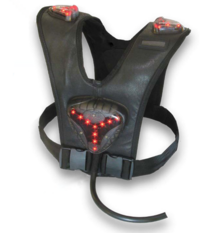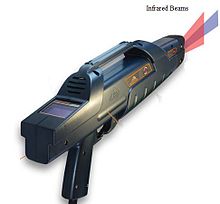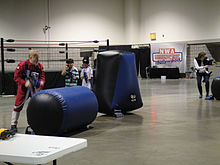Laser tag
hideThis article has multiple issues. Please help or discuss these issues on the talk page. (Learn how and when to remove these template messages)
|
| Nicknames | Lazer tag, Lasertag, Laser-tag, Lasergames, Laser Skirmish |
|---|---|
| First played | 1984 |
| Characteristics | |
| Contact | No physical contact between players is allowed (contact can result in penalties) |
| Team members | Varies depending on game format and level of play (recreational or professional) |
| Type | Indoor, outdoor, mobile, toy |
| Equipment | Laser guns and targets worn by players |


Laser tag is a recreational shooting sport where participants use infrared-emitting light guns to tag designated targets. Infrared-sensitive signaling devices are commonly worn by each player to register hits and are sometimes integrated within the arena in which the game is played.
Since its birth in 1979, with the release of the Star Trek Electronic Phasers toy manufactured by the South Bend Electronics brand of Milton Bradley, laser tag has evolved into both indoor and outdoor styles of play, and may include simulations of close quarter combat, role play-style adventure games, or competitive sporting events including tactical configurations and precise game goals. Laser tag is popular with a wide range of ages.
History[]
In late 1970s and early 1980s, the United States Army deployed a system using infrared beams for combat training. The MILES system functions like laser tag in that beams are "fired" into receivers that score hits.[1] Similar systems are now manufactured by several companies and used by various armed forces around the world.
The first known toy to use infrared light and a corresponding sensor was manufactured and marketed in 1979 as the Star Trek Electronic Phaser Guns set to accompany the release of Star Trek: The Motion Picture.[2]
In 1982, George Carter III began the process of designing an arena-based system for playing a scored version of the game, a possibility which had initially occurred to him in 1977 while watching the film Star Wars. The Grand Opening for the first Photon center was in Dallas, Texas on 28 March 1984.[3] Carter was honored by the International Laser Tag Association on 17 November 2005 for his contribution to the laser tag industry. The award is engraved "Presented to George A. Carter III in recognition for being the Inventor and Founder of the laser tag industry".[4]
In 1986, the first Photon toys hit the market, nearly simultaneously with the Lazer Tag toys from Worlds of Wonder and several other similar infrared and visible light-based toys. Worlds of Wonder went out of business around 1988, and Photon soon followed in 1989, as the fad of the games wore off. Today there are laser tag arenas all over the world bearing various names and brands, as well as a large variety of consumer equipment for home play and professional grade equipment for outdoor laser tag arenas and businesses.[5]
In 2010, a news article appeared claiming that Lee Weinstein developed and opened the first commercial laser tag facility. In June, 2011, the ILTA posted the results of a public record request from the City of Houston showing the opening date for Weinstein's "Star Laser Force" to have been 16 April 1985.[6]
Game mechanics[]
Laser tag systems vary widely in their technical capabilities and their applications. The game mechanics in laser tag are closely linked to the hardware used, the communication capabilities of the system, the embedded software that runs the equipment, the integration between the player's equipment and devices in the facility, the environment, and the configuration of the software that runs the equipment.
The resulting game play mechanics can result in anything from the highly realistic combat simulation used by the military to fantasy scenarios inspired by science fiction and video games.
Rate of fire, objectives, effects of being tagged, the number of lives, and other parameters can often be altered on the fly to provide for varied game play.
Specialty games[]
Along with standard team or solo matches, where one team or individuals try to tag the members of the other team or players repetitively, many laser tag venues will feature specialty matches. These matches vary based on equipment manufacturer and the level of technology of the system. Often they have various objectives and missions and demonstrate the technological capability of each system.
Specialty games include:
Capture the flag – this is where a player steals the opponents' flag and takes it back to his or her own base in order to score a point or win the match (depending on score system).
Protect the VIP – The team with the VIP must hide and conceal them for a set length of time while the opposing team tries to eliminate the VIP within the given time limit. There are several variants of VIP, where the VIP has to perform several actions in order to be "evacuated".
Stealth or Invisibility matches – Where the lights indicating a player's target sensors are deactivated.
Base-centric matches – where a team must defend a base while simultaneously attacking the opponent's base. Many prominent laser tag game systems, including LASERTRON, LaserBlast and Zone utilize this game format.
"Borg" matches – where players on a team share a pool of commonly held resources.
Juggernaut matches - One player is allocated as the 'juggernaut' and gains points for staying as the juggernaut. Other players attempt to eliminate this player and thus become the juggernaut themselves. Similar to Domination-style games.
Domination matches[7] – where a player gains points for possessing a field target for certain lengths of time.
Elimination matches – where a player is eliminated if tagged a certain number of times. Players may play individually (Battle Royale) or in teams. One variant of elimination mixes with Domination to force players to move instead of camping
Battle Royale matches[8] - where players eliminate each other until there is only one survivor, and where certain mechanisms are implemented to discourage camping. The game can be played solo, in duos or in squads.[9]
Evacuation matches - where one team doesn't possess the ability to respawn and has to defend against infinite number of opponents for a given amount of time
Role-Playing or Character Class-based games – where each player's equipment performs a different function.
Shoot out at the OK Corral - Players have only one life and line up shoulder to shoulder in two lines about six feet apart. On the command Go they start shooting until only one side remains.
Equipment and technology[]
At their core, laser tag systems typically use infrared signaling to track firing of the beam. In indoor play, a visible light combined with theatrical fog typically provide the visual effect of firing, while having no actual role in transmitting the fire signal.
In all but the most basic of systems, the infrared signal sent by the gun when it fires is encoded with information such as the identity of the pack from which it originated. This coding allows for scoring and may also act to discourage interference from unauthorized devices in the playing area.
Despite the name, laser tag equipment does not fire lasers, due to the potential dangers involved.[10]
Modern Laser Tag equipment allows the taggers to imitate various existing firearms and features numerous additional equipment such as control points, respawn boxes, portable med kits, landmines, grenade launchers and hand grenades.[11]
Indoor equipment[]

Indoor laser tag is typically played in a large arena (may or may not be dark) run by a commercial laser tag operator. The packs are tightly integrated with the devices inside the arena. The arena devices, and the packs themselves may be linked into a control computer for scoring and control over game parameters using radio equipment or infrared links. The game computer often serves to control other game effects and to manage player scores.
The dimensions of an indoor laser tag arena makes for close quarters, so there is a large design focus on performance and game play under these conditions.
There are many different brand names of indoor laser tag equipment manufactured by various independent corporations. Typically commercial laser tag sites will only utilize one specific brand of laser tag equipment. Equipment may be rented, purchased outright (commonly with exclusive repair agreements with manufacturer), operated under franchise, and in rare cases self-manufactured. Laser tag equipment is often branded as having the same name as the corporation which manufactures and installs it (e.g. Laser Storm was manufactured by Laser Storm Inc.).
Individual brands of laser tag equipment will often have a significant number of iterations, with significant upgrades often designated with sub-names to differentiate between other iterations. (e.g. names of various Laser Zone iterations include "Infusion", "Nexus", "Helios", in addition to others) These iterations can potentially represent large differences in the physical appearance of the equipment and the UI/functionality of the accompanying software and equipment itself. Typically, a given brand name of laser tag equipment will be referred to using its original brand name regardless of which individual upgrades/iteration a center operates.
Outdoor equipment[]
The equipment is generally expected to function well at longer ranges, even in daylight, so higher output power and specially designed optics are often a requirement. The units themselves are normally constructed of machined aluminum or poly-carbonate plastic to withstand the abuse the outdoors brings. Players usually wear lightweight head sensors to receive hits. Operators typically either run games like indoor laser tag where you count the number of times you tag other players, or scenarios often approximate real-world combat or a laser tag version of paintball games. Many businesses such as paintball fields are adding laser tag to attract new players.
Outdoor equipment also changes how laser tag is offered. It moved the game out of large warehouses into forest, brush and barren wasteland. Some mobile laser tag service companies have traveled more than 3,000 km to the austere places like 100 feet below ground in fallout bunkers, 100 miles from an electrical source in remote campsites, and 1,000 miles from paved roads in the high arctic to run laser tag games.
Competitions and tournaments[]
This article may contain an excessive amount of intricate detail that may interest only a particular audience. (May 2016) |
Competitions and tournaments are staged for local, regional/state, inter-regional, national, bi-lateral international, and international levels.
International[]
The Armageddon cross-system tournament was created in 2000.[12] Whereas most laser tag tournaments are limited to competition on one brand of laser tag equipment, the US Armageddon Tournament takes place over several days and is composed of a number of individual competitions held at multiple sites, each on different brands of laser tag equipment. The team with the most cumulative victories/points across all is the winner. The United Kingdom, Russia, and Sweden have operated/are currently operating tournaments utilizing the same format and bearing either the name "Armageddon" itself or local variations of the word.[13] The location and route of the tournaments is traditionally varied every couple of years to provide a more varied scope to the equipment and arenas that are a part of the tournament.
The First were hosted in the United States. Ultrazone's San Diego[14] site in California hosted Worlds I from 2–7 August 2003.
Bi-Lateral[]
Bi-lateral international championships have included:
- USA v Australia
- Australia v South Africa
National[]
National tournaments are conducted in various countries, including:
- Australia
- USA
- Sweden
- Finland
- UK
- Germany
- France
- Netherland September hosted by Laser tag Amsterdam
Regional and local[]
Individual Laser Tag systems often develop active tournament scenes. Unfortunately, due to the business practice of manufacturers not owning sites, these scenes tend to last only a few years and are player-organized and run. Ultrazone, when it had corporate-owned sites, ran tournaments up until about 2000. Laser Quest, with corporately-owned sites across North America, have operated the North American Challenge (or NAC for short) since 1995 and many local tournaments throughout the year. Laserforce has also maintained an international tournament scene for many years. LaserTron has also supported a tournament program for the past three years.[15]
LaserStorm may have the most successful tournament scene; it has variously featured ongoing regional tournaments in Pennsylvania, Ohio, Colorado, Michigan, Florida, Kansas, California, Wisconsin, and New York from the early 1990s until today. The "LaserStorm National Championship" is still held yearly, with the best teams from those regions traveling to one chosen host site every summer for a week long tournament to crown the yearly National Champions, and the best player in the country.
Darkzone (the Australian name for Ultrazone) has recently had its 10th annual National tournament also cementing it as one of the most stable competitions running in the world.
German law[]
In March 2009, upon the Winnenden school shooting, the German government announced that it would ban games such as laser tag and paintball, claiming that they trivialize and encourage violence. It later retracted this assertion.[16]
See also[]
References[]
- ^ Multiple Integrated Laser Engagement System, the Federation of American Scientists Military Analysis Network, accessed 13 November 2006
- ^ TagFerret's Laser Tag History Page, a historical reference to consumer laser tag product from a toy industry insider.
- ^ "Anniversary". Lasertagmuseum.com. 28 March 2014.
- ^ "Archived copy". Archived from the original on 20 July 2011. Retrieved 14 May 2011.CS1 maint: archived copy as title (link)
- ^ History of Laser Tag Archived 23 September 2006 at the Wayback Machine, International Laser Tag Association, accessed 17 September 2006
- ^ "History of the laser tag industry". Laser Tag Museum. Retrieved 29 April 2014.
- ^ http://adrenalinelasertag.com.sg/scenarios/
- ^ https://wielkaspluwa.pl/scenariusze/
- ^ "Battle Royale LIVE Game | Battlefield Sports". battlefieldsports.com. Retrieved 25 September 2019.
- ^ http://www.polyphoto.com/tutorials/LaserTag/NoRealLasers.html
- ^ https://wielkaspluwa.pl/czym_jest_laser_tag/
- ^ "Armageddon 2014 | The Ultimate Test of LaserTag Skill". A20xx.com. Retrieved 29 April 2014.
- ^ "> Home". UK Armageddon. Retrieved 29 April 2014.
- ^ "San Diego Laser – Ultrazone Tag". Ultrazonesandiego.com. Retrieved 29 April 2014.
- ^ LaserTron World Championships Archived 27 January 2013 at archive.today, LaserTron World Championships, accessed 28 October 2007
- ^ "Germany moves to outlaw paintball". BBC News. 9 May 2009.
| Wikimedia Commons has media related to Lasergame. |
- Laser tag
- Laser applications
- Live-action battle gaming
- Pervasive games
- Games and sports introduced in 1979